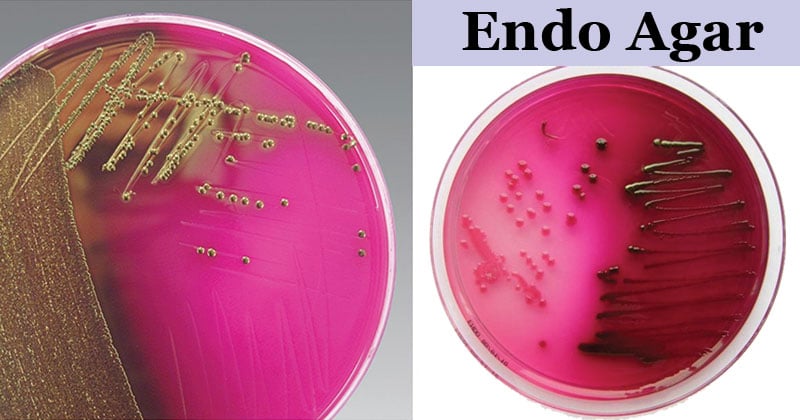- Endo Agar was developed by Endo to differentiate gram-negative bacteria on the basis of lactose fermentation while inhibiting gram-positive bacteria.
- Inhibition of the later was achieved without the use of bile salts as was traditionally used.
- Endo was successful in inhibiting gram-positive bacteria on his medium by the incorporation of sodium sulfite and basic fuchsin.
- The resulting Endo Agar, also known as Fuchsin Sulphite and Infusion Agar, was used to isolate the typhoid bacilli.
- Many modifications of this media have been done over the years.
- Endo Agar is today a selective medium recommended for confirmation of the presumptive test for members of the coliform group from clinical and non-clinical samples.

Interesting Science Videos
Composition of Endo Agar
| Ingredients | Gms/liter |
| Peptone | 10.000 |
| Lactose | 10.000 |
| Dipotassium phosphate | 3.500 |
| Sodium sulphite | 2.500 |
| Basic fuchsin | 0.500 |
| Agar | 15.000 |
Final pH (at 25°C): 7.5±0.2
Principle of Endo Agar
- The medium contains peptone which provides nitrogen, carbon, vitamins, and minerals required for bacterial growth.
- Sodium sulfite and basic fuchsin make this medium selective by suppressing gram-positive organisms.
- Lactose positive colonies exhibit a red color caused by the aldehyde reaction with the Sodium Sulfite and Basic Fuchsin.
- The development of a metallic sheen occurs when the organism produces aldehydes with the fermentation of Lactose. Lactose non-fermenting bacteria form clear, colorless colonies.
- Coliforms thus produce pink colonies on fermentation of lactose while lactose non-fermenters produce colorless colonies on the medium.
- With Escherichia coli, this reaction is very pronounced as the fuchsin crystallizes, exhibiting a permanent greenish metallic luster (fuchsin luster) to the colonies.
- If growth is colorless, beige or not pink, lactose is not utilized and it is probably a Gram-negative non-coliform.
- If good growth that is pink/red, lactose is utilized and the bacteria is probably a Gram-negative coliform.
- If good pink/red growth that has a bright metallic sheen, lactose is highly utilized and the bacteria is probably a Gram-negative coliform.
- (If poor or no growth, recall it is probably a Gram-positive organism.)
Preparation and Method of Use of Endo Agar
- Suspend 41.5 grams in 1000 ml distilled water.
- Heat to boiling to dissolve the medium completely.
- Sterilize by autoclaving at 15 lbs pressure (121°C) for 15 minutes.
- Mix well before pouring into sterile Petri plates.
Note: If the solidified culture medium is somewhat too red, then to remove the color add a few drops (max. 1 ml/liter) of a freshly prepared 10% Sodium sulfite solution and boil.
- Streak the specimen as soon as possible after it is received in the laboratory.
- The streak plate is used primarily to isolate pure cultures from specimens containing mixed flora.
- Alternatively, if the material is being cultured directly from a swab, roll the swab over a small area of the surface at the edge; then streak from this inoculated area.
- A nonselective medium such as Columbia Agar with 5% Sheep Blood must also be inoculated to provide an indication of other organisms present in the specimen.
- Incubate plates, protected from light, at 35 ± 2°C for 18 to 24 h.
Result Interpretation on Endo Agar
| Organisms | Growth |
| Klebsiella aerogenes | Good-luxuriant growth; pink colonies |
| Enterococcus faecalis | Poor growth; small pink colonies |
| Escherichia coli | Good-luxuriant growth; pink to rose red with a metallic sheen |
| Klebsiella pneumonia | Good-luxuriant; pink mucoid colonies |
| Proteus vulgaris | Good-luxuriant growth; Colourless to pale pink colonies |
| Pseudomonas aeruginosa | Good-luxuriant growth; Colourless, irregular colonies |
| Salmonella Typhi | Good-luxuriant growth; Colourless to pale pink |
| Enterobacter cloacae | Good growth; Pink colonies |
| Salmonella Typhimurium | Good-luxuriant growth; colorless colonies |
| Salmonella Enteritidis | Good-luxuriant growth; colorless colonies |
| Shigella flexneri | Good-luxuriant growth; colorless colonies |
| Enterobacter aerogenes | Good to excellent growth; Green, metallic sheen |
Uses of Endo Agar
- The medium is now used for the differentiation of lactose fermenting and non-lactose fermenting intestinal organisms, particularly during confirmation of the presumptive test for coliforms.
- Endo Agar is recommended by APHA as an important medium in the microbiological examination of water and wastewater, dairy products and foods.
- Endo Agar is used to confirming the detection and enumeration of coliform bacteria following presumptive test of drinking water.
- It is also used for the detection and isolation of coliforms and fecal coliforms from milk, dairy products, and food.
- Endo Agar is used for the enumeration of coliforms in water by the membrane filtration method in a laboratory setting.
Limitations of Endo Agar
- Besides Enterobacteriaceae, other gram-negative bacteria and yeasts may also grow.
- Avoid exposure of the medium to light, as it may lead to photooxidation and decrease the productivity of the medium.
- Overheating of the medium must be avoided, as it may destroy the productivity of the medium.
- Further biochemical tests must be carried out for further confirmation.
- If the inoculum is too heavy, the sheen may be suppressed.
- Occasionally, non-coliform organisms may produce typical sheen colonies. Coliform organisms may also occasionally produce atypical colonies, including dark red or nucleated colonies without sheen.

Good content. But, in my opinion, you should also include the E. Coli rapid test verification (to detect the presence of Beta Glucoronidase) and Indole testing. That is because some of the atypical colonies also somehow produce blue fluorocences to indicate the presence of Beta Glucoronidase.
all the contact of endo agar is very useful
Great post.